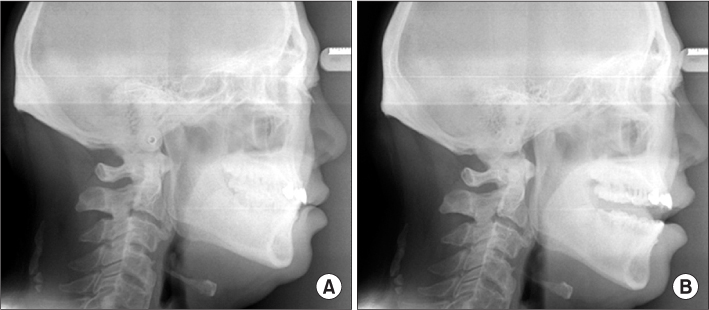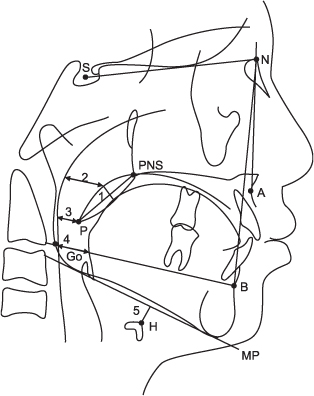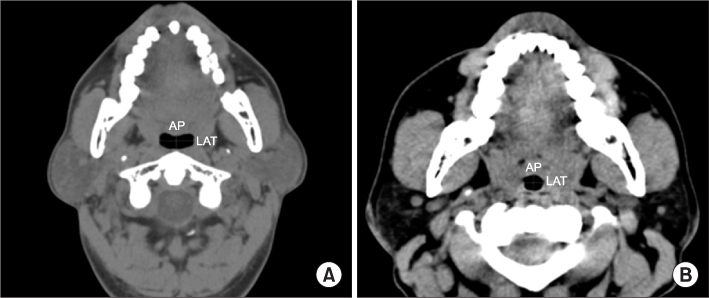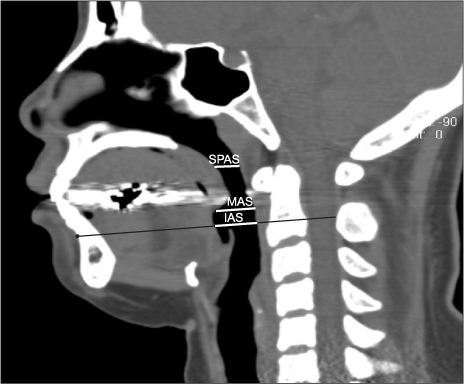J Korean Assoc Oral Maxillofac Surg.
2012 Oct;38(5):295-304. 10.5125/jkaoms.2012.38.5.295.
Retrospective study on the airway obstruction aspects of computed tomography and lateral cephalometry and the correlation of polysomnography in obstructive sleep apnea patients
- Affiliations
-
- 1Department of Oral and Maxillofacial Surgery, Department of Dentistry, Dong-A University Medical Center, Busan, Korea.
- 2Department of Nursing, Pukyoung National University, Busan, Korea.
- 3Department of Oral and Maxillofacial Surgery, Pusan National University Dental Hospital, Yangsan, Korea. inkchung@pusan.ac.kr
- KMID: 1434332
- DOI: http://doi.org/10.5125/jkaoms.2012.38.5.295
Abstract
OBJECTIVES
Lateral cephalometry, computed tomography (CT) and full-night polysomnography were used to examine the correlation of obstructive sleep apnea (OSA) severity.
MATERIALS AND METHODS
A total of 29 patients (5 females, 24 males) diagnosed with OSA were evaluated by lateral cephalometry, CT and full-night polysomnography. Lateral cephalometry was performed in the closed and open mouth states. The radiographic and polysomnography measurements of the patients with OSA were evaluated statistically to determine the association with OSA severity.
RESULTS
A significant relationship was observed between the increased respiratory disturbance index and closing lateral cephalometry. With mouth opening, the airway space narrowed and the OSA worsened. Lateral cephalometry revealed OSA patients to have an inferiorly positioned hyoid bone, longer-than-normal soft palate and narrowing airway space. As OSA was severe, the airway shape was ovoid in the CT horizontal view.
CONCLUSION
Polysomnography and the radiographic parameter can be used for diagnosing OSA.
MeSH Terms
Figure
Cited by 1 articles
-
Management of obstructive sleep apnea in a Treacher Collins syndrome patient using distraction osteogenesis of the mandible
İbrahim Damlar, Ahmet Altan, Berk Turgay, Soydan Kiliç
J Korean Assoc Oral Maxillofac Surg. 2016;42(6):388-392. doi: 10.5125/jkaoms.2016.42.6.388.
Reference
-
1. Foresman BH. Sleep and breathing disorders: the genesis of obstructive sleep apnea. J Am Osteopath Assoc. 2000. 100:8 Suppl. S1–S8.2. Morin CM, Colecchi C, Stone J, Sood R, Brink D. Behavioral and pharmacological therapies for late-life insomnia: a randomized controlled trial. JAMA. 1999. 281:991–999.
Article3. Brouillette RT, Thach BT. A neuromuscular mechanism maintaining extrathoracic airway patency. J Appl Physiol. 1979. 46:772–779.
Article4. Tiner BD, Waite PD. Peterson LJ, Indresano AT, Marciani RD, Roser SM, editors. Surgical and nonsurgical management of obstructive sleep apnea. Principles of oral and maxillofacial surgery. 1992. 6th ed. Philadelphia: J.B Lippincott Company;1531–1548.5. Bickelmann AG, Burwell CS, Robin ED, Whaley RD. Extreme obesity associated with alveolar hypoventilation; a Pickwickian syndrome. Am J Med. 1956. 21:811–818.6. Gastaut H, Tassinari CA, Duron B. Polygraphic study of the episodic diurnal and nocturnal (hypnic and respiratory) manifestations of the Pickwick syndrome. Brain Res. 1966. 1:167–186.
Article7. Choi JY, Engelke W. Cephalometric and nasopharyngeal endoscopic study in patients with obstructive sleep apnea. J Korean Assoc Maxillofac Plast Reconstr Surg. 1999. 21:149–165.8. White DP. Central sleep apnea. Med Clin North Am. 1985. 69:1205–1219.
Article9. Cisneros GJ, Trieger N. Bell WH, editor. Sleep apnea. Modern practice in orthognathic and reconstructive surgery. 1992. 9th ed. Philadelphia: W.B. Saunders Company;2020–2041.10. Partinen M, Telakivi T. Epidemiology of obstructive sleep apnea syndrome. Sleep. 1992. 15:6 Suppl. S1–S4.
Article11. Sleep-related breathing disorders in adults: recommendations for syndrome definition and measurement techniques in clinical research. The Report of an American Academy of Sleep Medicine Task Force. Sleep. 1999. 22:667–689.12. Meoli AL, Casey KR, Clark RW, Coleman JA Jr, Fayle RW, Troell RJ, et al. Hypopnea in sleep-disordered breathing in adults. Sleep. 2001. 24:469–470.13. Raj R, Hirshkowitz M. Effect of the new Medicare guideline on patient qualification for positive airway pressure therapy. Sleep Med. 2003. 4:29–33.
Article14. Meir HK, Thomas R, William CD. Management of obstructive sleep apnea-hypopnea syndrome: overview. 2006. 4th ed. New York: Elsevier;1111–1114.15. Young T, Palta M, Dempsey J, Skatrud J, Weber S, Badr S. The occurrence of sleep-disordered breathing among middle-aged adults. N Engl J Med. 1993. 328:1230–1235.
Article16. Shepard JW Jr, Gefter WB, Guilleminault C, Hoffman EA, Hoffstein V, Hudgel DW, et al. Evaluation of the upper airway in patients with obstructive sleep apnea. Sleep. 1991. 14:361–371.
Article17. Goldberg AN, Schwab RJ. Identifying the patient with sleep apnea: upper airway assessment and physical examination. Otolaryngol Clin North Am. 1998. 31:919–930.18. Sher AE, Schechtman KB, Piccirillo JF. The efficacy of surgical modifications of the upper airway in adults with obstructive sleep apnea syndrome. Sleep. 1996. 19:156–177.
Article19. Fujita S, Conway W, Zorick F, Roth T. Surgical correction of anatomic azbnormalities in obstructive sleep apnea syndrome: uvulopalatopharyngoplasty. Otolaryngol Head Neck Surg. 1981. 89:923–934.
Article20. Rivlin J, Hoffstein V, Kalbfleisch J, McNicholas W, Zamel N, Bryan AC. Upper airway morphology in patients with idiopathic obstructive sleep apnea. Am Rev Respir Dis. 1984. 129:355–360.
Article21. Riley R, Guilleminault C, Herran J, Powell N. Cephalometric analyses and flow-volume loops in obstructive sleep apnea patients. Sleep. 1983. 6:303–311.
Article22. Riley R, Guilleminault C, Powell N, Simmons FB. Palatopharyngoplasty failure, cephalometric roentgenograms, and obstructive sleep apnea. Otolaryngol Head Neck Surg. 1985. 93:240–244.
Article23. Oksenberg A, Silverberg DS. The effect of body posture on sleep-related breathing disorders: facts and therapeutic implications. Sleep Med Rev. 1998. 2:139–162.
Article24. Cartwright RD. Effect of sleep position on sleep apnea severity. Sleep. 1984. 7:110–114.
Article25. Oksenberg A, Silverberg DS, Arons E, Radwan H. Positional vs nonpositional obstructive sleep apnea patients: anthropomorphic, nocturnal polysomnographic, and multiple sleep latency test data. Chest. 1997. 112:629–639.
Article26. Pevernagie DA, Stanson AW, Sheedy PF 2nd, Daniels BK, Shepard JW Jr. Effects of body position on the upper airway of patients with obstructive sleep apnea. Am J Respir Crit Care Med. 1995. 152:179–185.
Article27. Fairburn SC, Waite PD, Vilos G, Harding SM, Bernreuter W, Cure J, et al. Three-dimensional changes in upper airways of patients with obstructive sleep apnea following maxillomandibular advancement. J Oral Maxillofac Surg. 2007. 65:6–12.
Article28. Saigusa H, Suzuki M, Higurashi N, Kodera K. Three-dimensional morphological analyses of positional dependence in patients with obstructive sleep apnea syndrome. Anesthesiology. 2009. 110:885–890.
Article29. Kim TK, Yang DK, Chung IK, Kim JR, Roh HJ. Cephalometric analysis of snoring and obstructive sleep apnea. J Korean Assoc Maxillofac Plast Reconstr Surg. 1996. 18:463–469.30. Martin SE, Marshall I, Douglas NJ. The effect of posture on airway caliber with the sleep-apnea/hypopnea syndrome. Am J Respir Crit Care Med. 1995. 152:721–724.
Article
- Full Text Links
- Actions
-
Cited
- CITED
-
- Close
- Share
- Similar articles
-
- Mean values of cephalometric analysis from Korean adults with abnormal occlusion in relation to the diagnosis of obstructive sleep apnea syndrome
- Roentgenographic Study of the Upper Airway in Patients with Obstructive Sleep Apnea Syndrome
- Comparison of Upper Airway Morphology between Position-Dependent Sleep Apnea Patients and Position-Independent Sleep Apnea Patients
- Contemporary Methods of Upper Airway Evaluation in Obstructive Sleep Apnea Patients
- Surgical Management of Obstructive Sleep Apnea Syndrome





